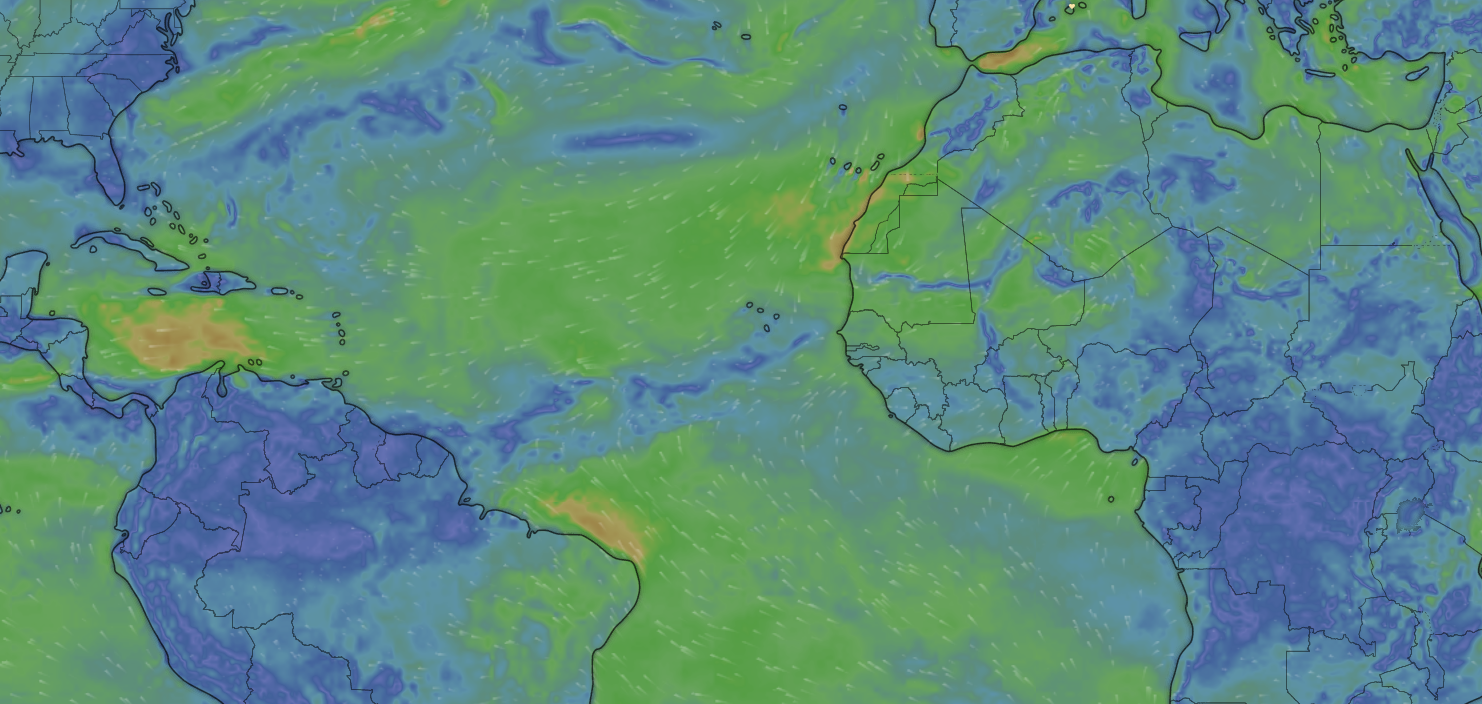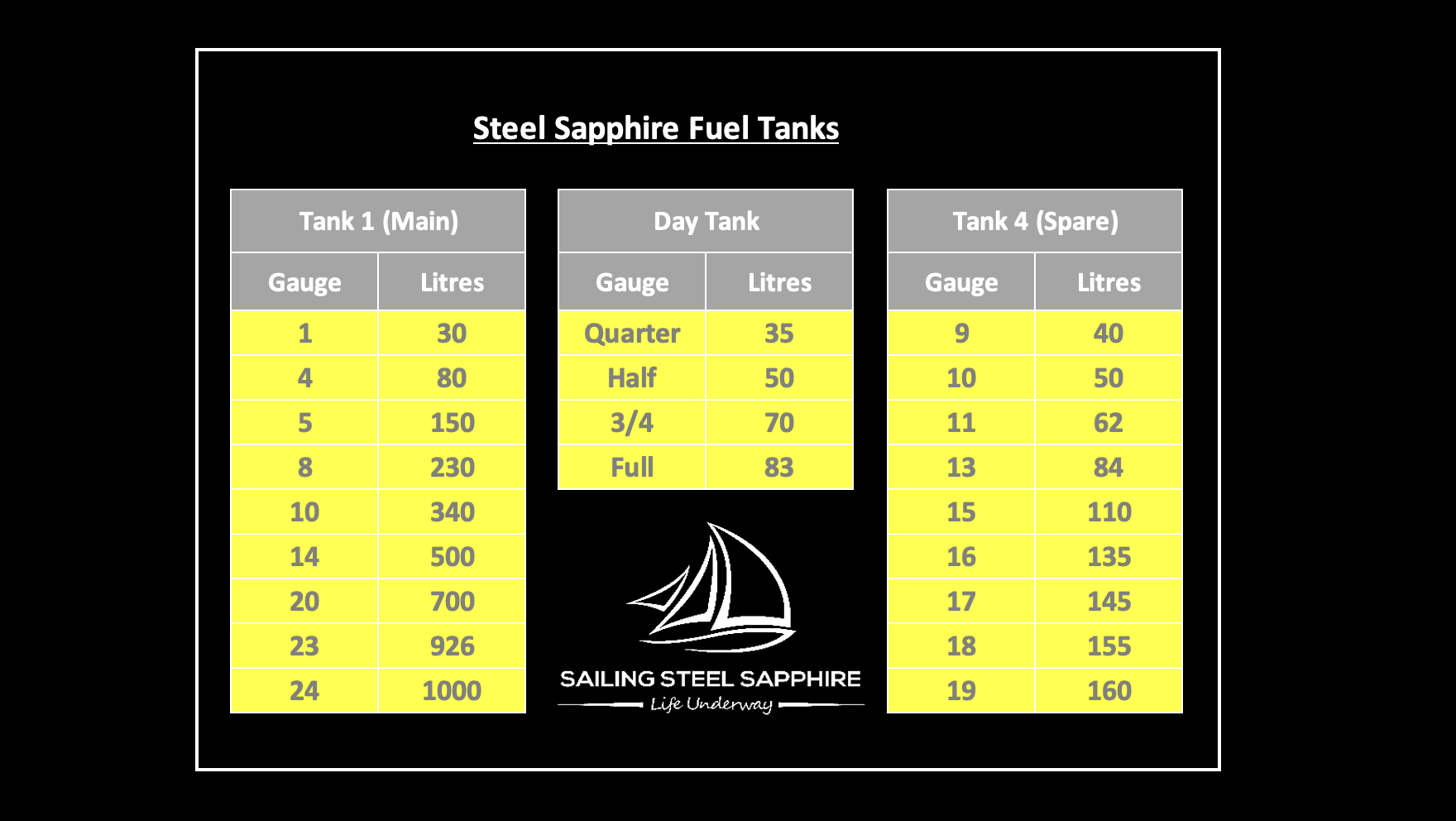The Longitudinal Bank

Day 9 : Ascension Island to Azores
Saturday, March 26th 2022
As we near the end of the ITCZ, we’ve been watching our fuel gauge and calculation spreadsheet very carefully.
We’re likely to come in either just under, or just over budget, but since it will be pretty close either way, it’s not going to matter very much thankfully, as we are keeping a substantial amount in reserve. But it’s been an interesting lesson in the accuracy of PredictWind and the importance of good planning.
Part of that has been identifying the optimum exit point for the ITCZ. We know that we have this LOOONNNGGG 1,500 mile upwind leg ahead of us, and so our thinking has been dominated by how to make that easier in any way possible.
Since we’ll be heading NW on a starboard tack for two weeks non-stop, we’ll end up a long way west of the Azores, and that’s all ground that will have to be made up, either by tacking back (and adding substantially more miles), or if we get lucky, the wind on the other side of the Azores High will have a westerly component to it and it will be easy to point directly for the Azores.
During the long beat, we’ll also be making a lot of leeway (where the boat slides sideways across the water, due to the lateral force of the wind and/or current), and that’s all ground that needs to be made up too.
So the best strategy to combat all of that is to exit the ITCZ as far East as possible, to give us some more miles “in the bank” so to speak. But as we’ve discussed before, the further East one crosses the ITCZ, the wider it is, and thus the more fuel one must burn. And to compound things, the further east one exits the ITCZ, the more Northerly (not North-easterly) the wind is, meaning you have to then aim more to the west to fill the sails.
It’s a Catch 22.
We’ve ended up gambling with a more easterly crossing than recommended. The guide books suggest we should have been aiming for around 25 or 26 degrees East, and we’ve actually chosen to aim for 22 degrees East, giving us an extra 180-240 miles of easting in the bank as we start the beat.
What’s enabled us to do that has been PredictWind’s accuracy (specifically ECMWF). While it can’t pick up the squalls, of course, it has been able to give us a lot of confidence about the underlying wind when those squalls blow themselves out. And it told us that the most easterly point we could aim for and still have NE winds when they finally arrive would be 22 degrees West.
So almost a week ago, we made the call to head more North than North West to take us to this magical, perfect, 22 degree exit point. And of course we’ve been watching the forecast like a hawk, since it can change quite a lot around here from day to day.
As predicted, there’s been very little underlying wind over the last 48 hours (less than 3 knots), so what sailing we’ve achieved has been during the squalls. But throughout that period, we’ve been wishing for the underlying wind to fill in, as it sometimes does in this area.
Yesterday, the latest forecast even delivered some extra good news - the wind would be arriving a day or two early, stick with us for 24 hours, and then die out again, before filling back in exactly at 6 degrees north, 22 degrees west.
The bad news – this extra little bonus bit of wind we’d been wishing for to help us conserve fuel,ws predicted to come from the “wrong" direction - due north!!
At 3pm yesterday it arrived, right on cue. And sadly, PredictWind was accurate about it’s direction too. It’s right on the nose – due North.
With around 100 miles still to go to where the north-Easterlies are due to begin, it’s far too far to just bear away and start sailing – we’ll end up back where we were originally meant to have been aiming for at around 25 degrees west, and have given up all the extra Easting we’ve been banking.
So there’s nothing for it but to continue motoring straight to our waypoint in 100 miles, even though we have a very sailable 8-12 knots wind – it’s so frustrating!
Through the night, we’ve been so tempted to turn off the engine and get the sails up (Coco has been pleading with us too!), but we’ve held our resolve, knowing we’ll be grateful over the coming two weeks.
The night also brought with it another surprise – copious quantities of weed. But sadly, not the type to make our current frustration more bearable.
The Atlantic Ocean is infamous for vast quantities of Sargasso weed, sometimes so dense it’s like sailing through a carpet. We’d heard about it, of course, but never seen it.
Last night, as I came on watch, I was looking down the side decks performing my customary horizon check, when I caught something floating past us, highlighted by the dim reflection of our steaming light half way up the mast.
Whatever it was, there was a lot of it. I grabbed the torch, and sure enough, large (but thankfully still well spread out) patches of weed.
That means two things, of course. No more fishing. But also the need to be very careful to continually monitor our raw water intake strainer for the engine.
Thankfully, by around midnight tonight, the engine will be off, hopefully for at least two weeks, and peace and quiet, will be restored.
You can take that to the bank.
Day 9 Statistics:
Time on passage so far: 8 days, 21 hours
Distance covered in last 24 hours: 109 nm
Average Speed in last 24 hours: 4.5 knots
Official Length of intended Route when we set out: 3,480 nm
Current Projected Distance to Go according to chart plotter: 2,316 nm
Distance Sailed so Far: 1069 nm
Total Projected Distance of Route: (2,316 + 1,069) 3,385 nm
Change in total projected distance in last 24 hours: -146 miles (I adjusted our next waypoint, NW of the Cape Verde islands, to take into account the extra miles of easting we now have in the bank, which has accounted for this significant shortening of the projected trip.
Motoring hours on Day 9: 17
Amount of fuel used so far from 350 litre ITCZ fuel budget: 264 litres (48 hours x 5.5 l/h)
Estimated miles to go until end of ITCZ : 94
Amount of motoring miles remaining in ITCZ budget: 86
Number of times we’ve discussed pulling out the sails in the last 24 hours since the Northerly winds arrived, only to decide to stay the course and keep getting the easterly miles in the bank: 5





